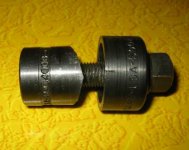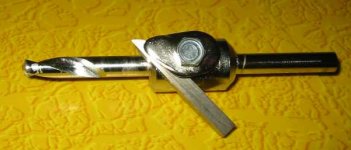Is it possible to make these recessed knob seats with a drill press? If not, how are they done? Thanks
Rob.
Rob.
An externally hosted image should be here but it was not working when we last tested it.
My guess is they are done with a milling machine.
That's the problem with making stuff that has real thick panels- most panel mount parts are made to go on thin panels, so you need a freakin' milling machine to make anything really massive.
The alternative to using such a thick panel is to epoxy a couple thinner panels to each other. Use a couple different panel materials and mutter something about "supressing single-material harmonic resonance" and they'll think you're Jimmy Neutron. Drill the small hole in the back piece, and use a hole saw in a drill press for the larger cutout in the front. Do the gluing after the holes are drilled/cut.
If you don't really care about the recess, but just want to mount the pot or switch and the panel is too thick, mount the pot or switch inside the box on a thin bracket and add a shaft extension to go through the panel. Then you can you can easily drill a reasonable size hole in the panel.
MR
That's the problem with making stuff that has real thick panels- most panel mount parts are made to go on thin panels, so you need a freakin' milling machine to make anything really massive.
The alternative to using such a thick panel is to epoxy a couple thinner panels to each other. Use a couple different panel materials and mutter something about "supressing single-material harmonic resonance" and they'll think you're Jimmy Neutron. Drill the small hole in the back piece, and use a hole saw in a drill press for the larger cutout in the front. Do the gluing after the holes are drilled/cut.
If you don't really care about the recess, but just want to mount the pot or switch and the panel is too thick, mount the pot or switch inside the box on a thin bracket and add a shaft extension to go through the panel. Then you can you can easily drill a reasonable size hole in the panel.
MR
Milling aluminum
Milling of aluminum panels can be done with a heavy duty router and proper carbide bits along with a fixture that allows the router to follow the desired outline. It is messy, noisy and produces lots of flying hot metal chips, but it can be done.
I have used this method to do panel work in the past and the results are very good when proper care is taken and sharp carbide bits are used. If you use this method make sure to wear the proper personnel protective equipment and eye protection. Hot metal on the skin or slammed into the eyes is not pleasant and could even cause the loss of an eye.
There are times when you must use what you have on hand to accomplish a desired task.
John Fassotte
Alaskan Audio
Milling of aluminum panels can be done with a heavy duty router and proper carbide bits along with a fixture that allows the router to follow the desired outline. It is messy, noisy and produces lots of flying hot metal chips, but it can be done.
I have used this method to do panel work in the past and the results are very good when proper care is taken and sharp carbide bits are used. If you use this method make sure to wear the proper personnel protective equipment and eye protection. Hot metal on the skin or slammed into the eyes is not pleasant and could even cause the loss of an eye.
There are times when you must use what you have on hand to accomplish a desired task.
John Fassotte
Alaskan Audio
Hi,
What MR and John have said is correct, and in order to make it clear, if you were able to mill these half-depth circular recesses out, you could not do it with one single 'pass'. i.e. with a single full diameter milling cutter.
The material (aluminium) would 'chatter' however firmly it was fixed down and the milling tool would 'grab' and surely spoil the job.
The only way to mill it like this would be to do what I have done a few times on the small miller I have on my lathe.
I use a 'dividing head', which can effectively be used as a 'rotating vice' on which the job is fixed, and then by taking 'passes' with a small cutter, gradually increasing the distance out towards the outer circumference of the recess, and all the while rotating the job on the dividing head.
With a long panel you need the room to 'swing' the entire panel around thro 360 degrees, which is a real problem, and having tried it several times, I would seek another method now.
I have also had some success with using a carefully ground (to ensure a flat base to the hole) 'fly cutter' in the vertical mill, also used on the lathe, the slides of which can be used for positioning the job, but, again, it is a real pain to set up properly.
Generally, I don't favour hole saws (unless maybe lubricated with say paraffin for aluminium) as they can chatter and grab etc, which leads to a poor surface finish on the job, but with care, it is possible to clean up the inside of such a hole by hand.
You do need to be fairly skilled (if you are fussy about appearances, like me!) to make a good job of this without rounding off the corners etc.
Is it not possible to try a local machine shop, who I have generally found to be very approachable for such jobs?
If you don't mind leaving a job with a machine shop so that they can 'work it in' between other jobs at a time to suit themselves, I doubt that you would be charged too much for this. It is certainly worthwhile asking, and if you can create some interest in what you are doing, I have had several such jobs done FOC.
Any good machine shop with a digitally controlled CNC type milling machine could make a superb job with very clean sides and base of the recess, as to them it is just child's play!
Regards,
What MR and John have said is correct, and in order to make it clear, if you were able to mill these half-depth circular recesses out, you could not do it with one single 'pass'. i.e. with a single full diameter milling cutter.
The material (aluminium) would 'chatter' however firmly it was fixed down and the milling tool would 'grab' and surely spoil the job.
The only way to mill it like this would be to do what I have done a few times on the small miller I have on my lathe.
I use a 'dividing head', which can effectively be used as a 'rotating vice' on which the job is fixed, and then by taking 'passes' with a small cutter, gradually increasing the distance out towards the outer circumference of the recess, and all the while rotating the job on the dividing head.
With a long panel you need the room to 'swing' the entire panel around thro 360 degrees, which is a real problem, and having tried it several times, I would seek another method now.
I have also had some success with using a carefully ground (to ensure a flat base to the hole) 'fly cutter' in the vertical mill, also used on the lathe, the slides of which can be used for positioning the job, but, again, it is a real pain to set up properly.
Generally, I don't favour hole saws (unless maybe lubricated with say paraffin for aluminium) as they can chatter and grab etc, which leads to a poor surface finish on the job, but with care, it is possible to clean up the inside of such a hole by hand.
You do need to be fairly skilled (if you are fussy about appearances, like me!) to make a good job of this without rounding off the corners etc.
Is it not possible to try a local machine shop, who I have generally found to be very approachable for such jobs?
If you don't mind leaving a job with a machine shop so that they can 'work it in' between other jobs at a time to suit themselves, I doubt that you would be charged too much for this. It is certainly worthwhile asking, and if you can create some interest in what you are doing, I have had several such jobs done FOC.
Any good machine shop with a digitally controlled CNC type milling machine could make a superb job with very clean sides and base of the recess, as to them it is just child's play!

Regards,
recessed
I too think the best way is (safest) to go to a machine shop and ask.
if however there is no place like that in your area, there is another way , but it takes a while.
you can buy all kinds of sanding heads (made of hard combined grit) in all shapes and sizes. you can have cylindrical, flat like a pancake etc.. they fit in drills like the dremel or bigger sizes.
you do need a drill table/base.
fist make a hole in the center wide enough so that the top of the sanding center (sonetimes it's a small nut) can go in without touching the aluminum.
then put the sanding head in the drill and start very very slowly sanding. in order to avoid high temp, use water or special oil, it increases the sandingprocess without overheating the alu.
use a depth meter for the sanding, you need to make it look professional right?
hope i could help you.
J-P
I too think the best way is (safest) to go to a machine shop and ask.
if however there is no place like that in your area, there is another way , but it takes a while.
you can buy all kinds of sanding heads (made of hard combined grit) in all shapes and sizes. you can have cylindrical, flat like a pancake etc.. they fit in drills like the dremel or bigger sizes.
you do need a drill table/base.
fist make a hole in the center wide enough so that the top of the sanding center (sonetimes it's a small nut) can go in without touching the aluminum.
then put the sanding head in the drill and start very very slowly sanding. in order to avoid high temp, use water or special oil, it increases the sandingprocess without overheating the alu.
use a depth meter for the sanding, you need to make it look professional right?
hope i could help you.
J-P
I would be reluctant to use sanding heads, since the edges will never be perfect. One way to do it at home is to just cut it out through (using jigsaw, drill or whatever other convenient method), finishing the opening by hand with a file or rotary file mounted on a grinder. Then attaching another plate at the back, with much smaller hole to hold the potentiometer or the switch.
Some info on cutting large holes can be found in this thread: http://www.diyaudio.com/forums/showthread.php?s=&threadid=8877&highlight=grinder
Some info on cutting large holes can be found in this thread: http://www.diyaudio.com/forums/showthread.php?s=&threadid=8877&highlight=grinder
- Status
- This old topic is closed. If you want to reopen this topic, contact a moderator using the "Report Post" button.
- Home
- General Interest
- Everything Else
- Recessed Knobs?

